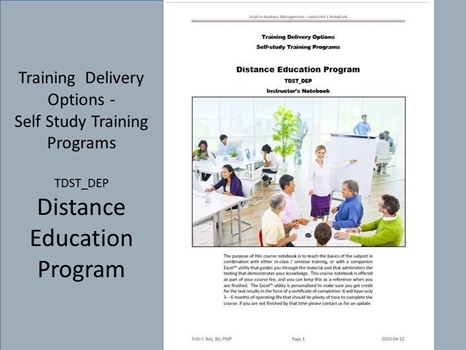
Distance Education Program TDST_DEP
This course is a “trial” to explore how the distance education program works, and whether the student is able to learn in this mode. Typically candidates live and/or work too far away to attend training classes, and they do not have access to Internet services that allow them to study the material, not even using resources at the local library or community centers. In this course we go through the mechanics of how distance education facilities are blended into courses described in other sections on this site. Although there are limitations caused by the fact that no teacher-student interaction is available, determined individuals can use optional tools that can be requested to pursue the training through distance education.
Timing is a challenge in distance education: waiting for mail delivery slows the interaction with a teacher so students generally cannot wait for feedback and still remain actively engaged in learning. For this reason we encourage students to work with a coach who can help them study the materials, and who (hopefully) is able to expedite the process of feedback. We developed an Excel™ based learning program that works for individuals who at least have access to a computer equipped with MS-Office software, to help them to explore the training notebook one section at a time and answer multiple-choice questions that validate their understanding of the materials.
The major difference from on-line study is that we minimize dependency on the internet, so individuals may be able to upload or download material via a USB memory stick as they work with a coach or other support person. There is a loss in quality due to the absence of a teacher in real-time dialog with students while presenting the subject matter, but even after taking that in stride there are unique opportunities that would otherwise not be available in their area. In a worst-case scenario the USB memory stick can be exchanged by regular mail in order to make training possible – we work with individual students to sort out a mechanism that works for them.
Our training materials are provided in the form of PDF notebooks, mindful of students that may have limited on-line time. They can download these notebooks and related materials that will be sent to them via Email upon completing their registration. In lieu of an instructor, there will be a guide that steps students through the notebook and that provides materials for self-testing, and in many cases URL’s to websites where students can do further research.
Where practical depending on the subject matter we use Excel™-based simulations to reinforce the learning process, the same as what we use in our classroom training programs for homework assignments. Access to a computer with MS-Office™ is a requirement to partake of our training, but internet access is optional (see distance learning). The Excel™ workbooks are protected so that only registered students can make use of the tools needed to complete the course.
The Excel™ learning management process is designed to offer maximum flexibility in learning. Whereas on-line interactive learning requires that a student is connected to the internet, most of our learning can take place in off-line mode so that students can make use of the time spent on public transit, for example, to review course materials and take notes. The only time students need to be connected to the internet is when they upload or download information.
We have a unique Excel™-based “guidance system” that monitors student progress and that can administer tests that the student can forward to get the course completion certificate for credit. Students can repeat the tests that are based on a randomized selection of questions, so each time their test appears to be unique. Students can work together in a group session, but each “guidance system” is personalized so that only the individual that is registered can obtain the course completion certificate for credit. The Excel™ workbooks are protected so that only registered students can make use of the tools needed to complete the course.
Learning Formats TDST_DEP
This course is currently available in an on-line or distance learning format with approximately 15 contact hours to give the student a hands-on sense of what it will be like to complete their training in this fashion.
PDF – Certificate Of Completion
Each course offers a certificate of completion that identifies the course, the student, and a brief description of the course. To receive a certificate the student must have attended at least 80% of the course sessions. This personalized certificate is forwarded to the student by Email.
PDF – Course Notebook
Each course includes a notebook in PDF format that provides the minimum knowledge the student must master in order to obtain the certificate. In the notebook you will find references to other study materials. Students receive the notebook by Email when their registration is confirmed.
PDF – Program Overview
An overview of this study program can be downloaded from the website by right-clicking on the program link on the enquiry page.
PDF – Current Training Schedule
A list of upcoming training sessions can be downloaded from the website by right-clicking on the schedule link on the enquiry page.
Registration – Service Providers
To register for any training course please look on the enquiry link page of your service provider (from where you accessed this website). On the page you will find a registration request form where you can order the course that you are interested in. The availability dates will be provided to you, along with payment instructions if you decide to go ahead.

 |
|